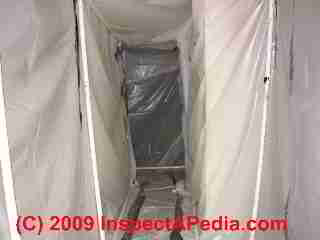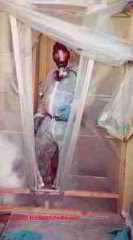 Cross Contamination during Mold Cleanup
Cross Contamination during Mold Cleanup
Mold Remediation Mistakes to Avoid
- POST a QUESTION or COMMENT about cross contamination during mold remediation
Mold cleanup job mistakes: avoid cross contamination of moldy dust & debris. .
One of the most common and most costly mistakes we hear about from readers are mold cleaning projects that blow moldy dust (or track sewage) throughout the otherwise un-affected areas of a building.
Here we explain how an cross contamination by moldy dust or relying just on "mold sprays and paints" can end up costing unnecessarily when hiring a mold cleaning company.
This article series describes common mistakes people make when attempting to clean up mold. Photo at page top courtesy of Anabec systems.
InspectAPedia tolerates no conflicts of interest. We have no relationship with advertisers, products, or services discussed at this website.
- Daniel Friedman, Publisher/Editor/Author - See WHO ARE WE?
CROSS CONTAMINATION of MOLD - Be sure to protect from mold spore cross contamination of other building areas when cleaning up mold
Small mold cleanup projects (less than 30 sq.ft.) can normally be handled as a simple building cleaning or renovation project and without expensive negative air and dust containment barriers.
But during a "small project" you should remain alert for the discovery of a previously unrecognized large area of contaminated materials. If the small project discovers that it has become a large one, work should stop to permit set-up of proper dust and particle containment.
When a large building area (more than 30 sq.ft. of contiguous moldy material) is to be cleaned, use of negative air and dust containment are appropriate.
Our photo shows a typical use of plastic pipe frames to support a 6-mil poly dust barrier giving a passage through a building into the mold cleanup area. Our page top photo shows a typical two-barrier air-lock that provides entry and exit into the work area through the containment.
Protect the building areas outside or around the one being cleaned from mold contamination by following published mold remediation guidelines such as the NY City Mold Cleanup guidelines.
For large products (more than 30 sq.ft. of contaminated contiguous surface), the procedure involves tenting or sealing off the work area using plastic barriers, combined with establishing negative air pressure inside the work area so that particles and dust do not tend to escape the work area.
It is important that the mold contractor protect workers performing remediation using appropriate masks, clothing, etc. Occupants, particularly people at extra risk of mold-related illness should not perform nor be present during this work. We sometimes meet mold cleanup crews who do not understand English, have been given no instruction, and have not been giving any protective gear.
Don't spray or power-wash moldy wood or other moldy surfaces without proper containment as you may be simply spreading mold spores around the indoor environment where you will infect other materials.
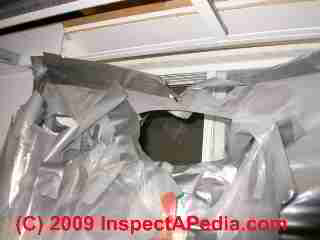 Do not take down the mold demolition dust containment barrier before the building has successfully passed a mold remediation clearance inspection and test. If the cleanup was not complete, properly performed, and successful, early dust barrier removal risks cross-contamination into other building areas.
Do not take down the mold demolition dust containment barrier before the building has successfully passed a mold remediation clearance inspection and test. If the cleanup was not complete, properly performed, and successful, early dust barrier removal risks cross-contamination into other building areas.
Very troublesome has been our observation of frequent complete failures of "mold dust containment" systems set up by un-trained workers.
The result is invariably an increase in the ultimate mold remediation project cost when additional wiping and HEPA vacuuming have to be performed in areas not previously contaminated with mold.
Containment and Negative Air Errors at mold remediation projects include improper containment barrier construction that leaves holes and leaks, collapsing containment systems that simply don't stay in place, combined with workers who simply keep on with demolition even though the containment barrier has collapsed.
It's not too difficult to spot incompetent mold containment barriers (photo at left).
But some mold dust containment barrier setups are downright stupid.
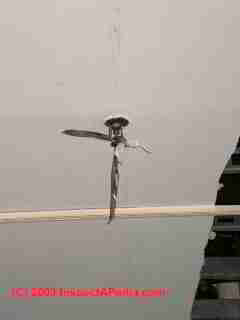 at a New York City mold remediation project we found that the low-budget mold remediation company selected by our client hung plastic up like a shower curtain, (not reaching the ceiling) by suspending it using duct tape strips tied around the fire sprinkler heads along the ceiling!
at a New York City mold remediation project we found that the low-budget mold remediation company selected by our client hung plastic up like a shower curtain, (not reaching the ceiling) by suspending it using duct tape strips tied around the fire sprinkler heads along the ceiling!
Not only had the remediator taken down the containment barrier before the project had successfully passed a mold clearance inspection and test, they had left their duct tape plastic strips tied to the fire sprinklers (photo at left).
Luckily no one stumbled into the "shower curtain" containment system or the building would have had a new shower of its own, with new mold problems.
And luckily the building had not caught on fire - we don't know how the duct tape might have interfered with proper functioning of the sprinkler heads in the event of a fire.
Also ineffective is simply "air scrubbing", running power dryers, or power dehumidifiers in a moldy dusty area, without also performing the cleanup and fixing any ongoing water entry problems or water leaks.
Turning on a large air filtration machine with no ducting to outdoors.
The result may stir up and remove dust that is airborne, but an air scrubber is completely incapable of removing mold from building surfaces nor can it pick up debris on the floor across the room, any more than you can vacuum your living room carpet by standing in the kitchen and waving your vacuum cleaner wand in the air.
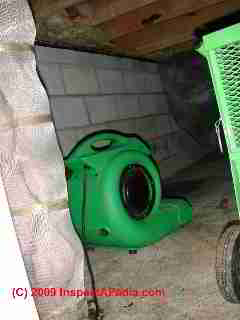 Our photo shows a "post mold remediation" condition we observed while inspecting a property for a large homeowners' insurance provider. Things didn't look quite right:
Our photo shows a "post mold remediation" condition we observed while inspecting a property for a large homeowners' insurance provider. Things didn't look quite right:
- A drier and dehumidifier were left running in a moldy crawl space that was still wet (see that dark spot at center of the photo)
- Demolition was incomplete (see the fiberglass insulation in the upper left of the photo)
- There was no evidence that any dust containment had ever been in place, though this crawl space communicated with the rest of the building via several major air pathways.
See
- MOLD REMEDIATION & CLEANUP STANDARDS
- MOLD LEVELS allergenic or toxic mold: how much means a problem
USING BLEACH - Bleach as a "Mold Medicine" to try to kill mold or prevent mold in buildings
This discussion has moved to RELYING on BLEACH on MOLD
...
Continue reading at MOLD PRODUCTS, INEFFECTIVE or select a topic from the closely-related articles below, or see the complete ARTICLE INDEX.
Or see these
Recommended Articles
- CHOOSE a FLOOD DAMAGE RESTORATION or MOLD REMEDIATOR
- MOLD ACTION GUIDE - WHAT TO DO ABOUT MOLD
- MOLD CLEANUP GUIDE- HOW TO GET RID OF MOLD - home
- MOLD CLEANUP - MISTAKES to AVOID
- MOLD CLEANUP, SAFETY WARNINGS
Suggested citation for this web page
MOLD CLEANUP AREA CROSS CONTAMINATION at InspectApedia.com - online encyclopedia of building & environmental inspection, testing, diagnosis, repair, & problem prevention advice.
Or see this
INDEX to RELATED ARTICLES: ARTICLE INDEX to MOLD CONTAMINATION & REMEDIATION
Or use the SEARCH BOX found below to Ask a Question or Search InspectApedia
Ask a Question or Search InspectApedia
Try the search box just below, or if you prefer, post a question or comment in the Comments box below and we will respond promptly.
Search the InspectApedia website
Note: appearance of your Comment below may be delayed: if your comment contains an image, photograph, web link, or text that looks to the software as if it might be a web link, your posting will appear after it has been approved by a moderator. Apologies for the delay.
Only one image can be added per comment but you can post as many comments, and therefore images, as you like.
You will not receive a notification when a response to your question has been posted.
Please bookmark this page to make it easy for you to check back for our response.
IF above you see "Comment Form is loading comments..." then COMMENT BOX - countable.ca / bawkbox.com IS NOT WORKING.
In any case you are welcome to send an email directly to us at InspectApedia.com at editor@inspectApedia.com
We'll reply to you directly. Please help us help you by noting, in your email, the URL of the InspectApedia page where you wanted to comment.
Citations & References
In addition to any citations in the article above, a full list is available on request.
- Our recommended books about building & mechanical systems design, inspection, problem diagnosis, and repair, and about indoor environment and IAQ testing, diagnosis, and cleanup are at the InspectAPedia Bookstore. Also see our Book Reviews - InspectAPedia.
- In addition to citations & references found in this article, see the research citations given at the end of the related articles found at our suggested
CONTINUE READING or RECOMMENDED ARTICLES.
- Carson, Dunlop & Associates Ltd., 120 Carlton Street Suite 407, Toronto ON M5A 4K2. Tel: (416) 964-9415 1-800-268-7070 Email: info@carsondunlop.com. Alan Carson is a past president of ASHI, the American Society of Home Inspectors.
Thanks to Alan Carson and Bob Dunlop, for permission for InspectAPedia to use text excerpts from The HOME REFERENCE BOOK - the Encyclopedia of Homes and to use illustrations from The ILLUSTRATED HOME .
Carson Dunlop Associates provides extensive home inspection education and report writing material. In gratitude we provide links to tsome Carson Dunlop Associates products and services.


